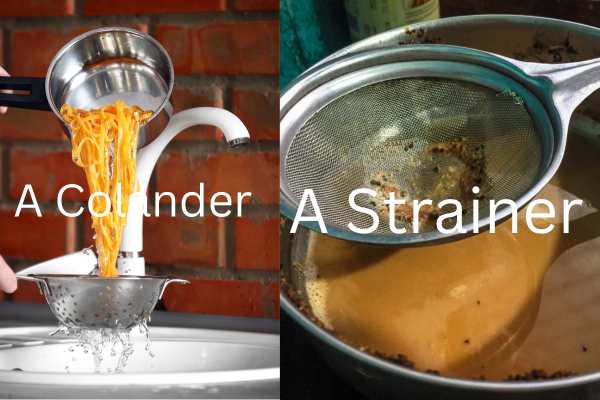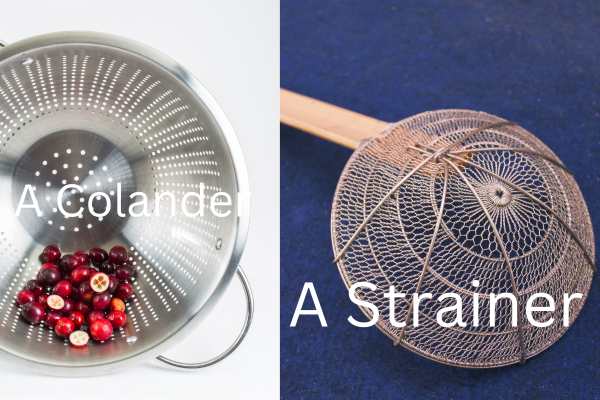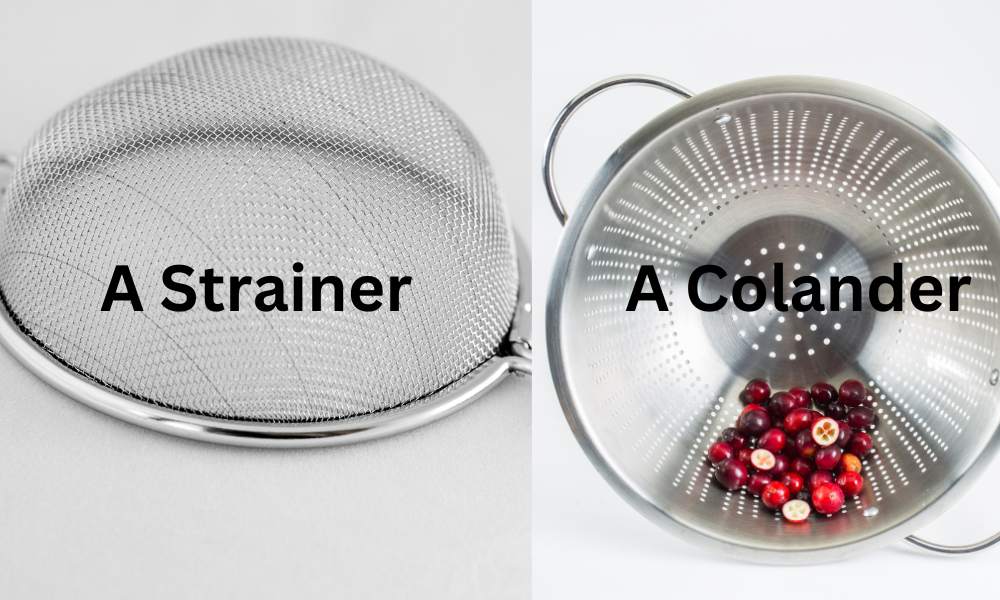Understanding the difference between a colander and a strainer is essential for anyone who spends time in the kitchen, as both utensils serve distinct purposes in the culinary world. A colander is typically a large, bowl-shaped container with holes throughout, designed for draining water from cooked pasta or washed vegetables. On the other hand, a strainer, often made of wire mesh, is used for separating liquid from solid ingredients, perfect for tasks such as sifting flour or straining tea leaves. Although they might appear similar at first glance, recognizing their unique functions can greatly enhance your cooking efficiency and precision.
What Is A Colander?
A colander is a kitchen utensil that many might recognize by its distinctive, bowl-like shape perforated with numerous holes. This design is specifically tailored for the task of draining liquids from foods such as pasta, freshly washed vegetables, or even fruits. Colanders are typically made from materials like metal, plastic, or silicone. And are equipped with handles on either side, allowing them to be securely held over a sink or pot. The size and spacing of the holes Use in a colander are ideal for strainer larger items, ensuring that while excess water is quickly removed, the food remains safely contained.
What Is A Strainer?
On the flip side, a strainer is another kitchen essential, but it serves a slightly different purpose. Strainers often feature a fine mesh basket and a handle, designed to filter out smaller particles from a liquid. This makes them perfect for tasks such as removing tea leaves from brewed tea, sifting flour to break up clumps, or straining homemade stocks to achieve a clear broth. Strainers can come in various sizes and shapes, from large, bowl-shaped versions for bigger tasks to smaller, handheld types for quick, everyday kitchen duties.
Key Differences Between Colander And Strainer
1. Design And Construction

The primary distinction between a colander and a strainer lies in their design and construction. A colander is usually a larger, bowl-shaped utensil with holes punctured throughout its body, designed to drain water from foods such as pasta or vegetables. Typically made from metal, plastic, or silicone, colanders are robust and often come with handles on either side to facilitate easy handling and stability when placed over a sink or pot. The holes in a colander are relatively larger, making it suitable for draining items without the risk of them slipping through.
2. Intended Use

The intended use of each utensil highlights their practical differences in the kitchen. A colander’s design is optimized for draining excess liquid from relatively large, solid food items quickly and efficiently. It’s perfect for when the size of the food particles is not a concern, but rapid drainage is, such as when cooking pasta, washing vegetables, or letting canned beans rinse and drain.
Conversely, a strainer is the tool of choice when dealing with finer substances or when needing to remove small particles from liquids. Its fine mesh allows it to capture and separate fine particles from both liquid and dry ingredients. This makes it indispensable for baking, when ensuring lump-free flour is essential. The preparation of broths and teas, where clarity and purity of the liquid are desired outcomes.
3. Material Varieties

Colanders and strainers are available in a range of materials, each offering unique benefits for specific culinary tasks. Colanders are commonly made from stainless steel, plastic, or silicone. Stainless steel colanders are durable, resistant to high temperatures. And ideal for heavy-duty use, but they can be heavier and more cumbersome to handle. Plastic colanders are lightweight and often more colorful, making them a popular choice for home kitchens. They may not withstand high temperatures as well as metal options. Silicone colanders combine the best of both worlds, offering heat resistance, flexibility. And a non-slip surface, though they may not offer the same rigidity as metal or plastic versions for heavier foods.
Strainers, on the other hand, typically feature a metal or cloth mesh. Metal mesh strainers are sturdy and ideal for tasks requiring precision, such as sifting fine flours or straining stocks. They can handle a range of temperatures and are generally easy to clean. Cloth strainers, such as cheesecloth or muslin, are perfect for ultra-fine straining needs, such as making cheese, yogurt, or clarifying broths. While offering unparalleled fineness in straining, cloth materials require more maintenance and may not be as durable over time.
4. Size and Capacity

The size and capacity of colanders and strainers vary widely, catering to different food preparation needs. Colanders typically come in larger sizes, reflecting their use in draining significant quantities of food. Such as a whole pot of pasta or a large batch of washed fruits and vegetables. Their bowl-like shape and larger holes allow for quick draining of large volumes of water. Making them suitable for family-sized meals and bulk food processing.
Strainers range from wide, bowl-shaped designs to smaller, handheld models. The larger ones can handle tasks similar to a colander but are particularly useful. When you need to strain or sift large volumes of ingredients while retaining fine particles. Smaller strainers are designed for more delicate tasks. Such as dusting powdered sugar on desserts or straining loose tea leaves from a single cup of tea. The variety in size and capacity ensures that there’s a strainer suitable for both large-scale cooking and more precise, small-scale preparation.
When to Use a Colander?
A colander is your go-to kitchen utensil when you need to drain large quantities of water from foods quickly and efficiently. It’s ideal for:
- Draining Pasta: After boiling pasta, a colander allows you to drain the hot water safely and conveniently.
- Washing Fruits and Vegetables: Colanders provide an excellent way to wash and then drain water from fresh produce under running water.
- Rinsing Canned Goods: To remove excess sodium or preservatives, rinsing beans, vegetables, or tuna in a colander is very effective.
The colander’s larger holes and typically wide, bowl-shaped design make it unsuitable for finer tasks, like straining broth or sifting flour, but perfect for the tasks above.
When to Use a Strainer?
A strainer, with its fine mesh or cloth, is designed for more delicate operations. Where separating small particles from a liquid or fine powder is necessary. Use a strainer for:
- Sifting Dry Ingredients: Achieving lump-free flour for baking by sifting through a strainer ensures a smoother mixture.
- Straining Stocks and Soups: To achieve a clear broth or soup, a strainer can remove fine particles and impurities.
- Brewing Loose Tea: For a perfect cup of tea without leaves in your drink, a small strainer can catch the leaves after steeping.
Strainers cater to tasks requiring precision and are essential for both cooking and baking when clarity and texture matter.
Conclusion
Understanding when to use a colander versus a strainer hinges on the specific needs of your cooking or baking task. Colanders are best suited for large, bulky tasks that involve draining significant amounts of water from foods. Making them indispensable for everyday cooking activities like preparing pasta or cleaning vegetables. Strainers, with their fine meshes, are tailored for more delicate tasks that require separating fine particles from liquids or powders, crucial for achieving the desired textures and clarity in dishes. By choosing the appropriate tool based on the task at hand, you can enhance your culinary creations. Ensuring that they not only taste good but also meet the expected aesthetic and texture standards.
